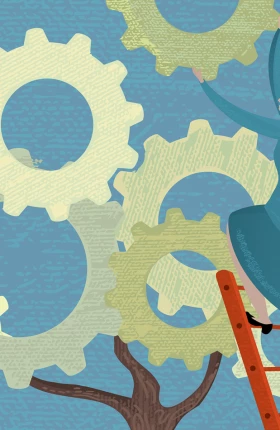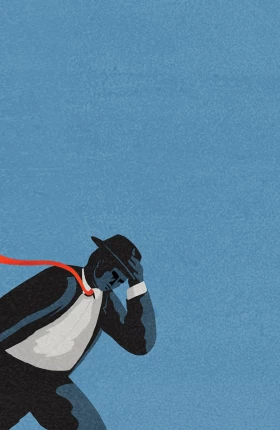Disk drive designer and manufacturer Seagate Technology is the number two company in the global technology sector in the BCG 2014 Value Creator rankings. In the five years from 2009 through 2013, the company had an average annual TSR of 70.3 percent. Seagate’s consistent focus on the impact of its business and financial decisions on TSR helped the company and its senior executives navigate an extremely turbulent business environment, while still delivering industry-leading TSR. (See Exhibit 1.) How it did so is also a classic case study of how to orchestrate a TSR turnaround and deliver superior value creation after an extended period of below-average performance.
A Changing Industry
Founded in 1979 by five technology entrepreneurs and executives who had played a key role in the early development of hard-disk drives, Seagate is a first-generation Silicon Valley company. By the end of the last century, it was the global leader in disk drives. In 1999, the company, led by then-CEO Steve Luczo, went private in a highly successful leveraged buyout, and it went public again at the end of 2002. Shortly after, Luczo stepped down as CEO to become board chairman.
By 2007, however, Seagate faced a challenging situation. In its early years, the disk drive industry, like many high-tech businesses, featured a combination of characteristics that fed rapid growth: high demand driven by the rapid expansion in computing and storage, regular technology advances (in particular, growth in so-called aerial density, or the amount of data that can be packed onto a drive), and a highly fragmented customer base and competitor set.
By the turn of the new century, all that was changing. The sector was consolidating, with fewer players and fewer and bigger customers. Innovation was slowing down and product cycles were getting longer. Meanwhile, new and potentially disruptive technologies, such as solid-state drives, were entering the data storage space. All these developments were leading investors to view the traditional disk-drive business as a risky investment with an uncertain future, putting downward pressure on valuations. Seagate was trading at a low multiple of roughly two to four times earnings.
What’s more, the strategy the company had pursued to address some of these changes in the market landscape wasn’t working. In an effort to expand its product portfolio and target new growth opportunities, the company had reorganized into market-facing business units. But at the same time, it began to fall behind in technology development in its core disk-drive business. Both margins and market share were declining, and the company’s estimates for future profits were moving into the red.
Senior executives were convinced that new business trends, such as cloud computing, would continue to drive further growth in the disk drive market. But it would require major new investments in core technology to improve the company’s competitive position. By 2008, those investments were well under way, but without much positive impact on the company’s stock price.
A Struggle for Survival
Then, as if refreshing the company’s technology platform weren’t challenge enough, Seagate—like many companies—was buffeted in 2008 and 2009 by a once-in-a-lifetime event: the global financial crisis and subsequent downturn. The company was highly leveraged, and the slowdown put it at risk of default. “We had a serious covenants issue,” recalls Pat O’Malley, who became Seagate’s CFO in August 2008. “We were trying to prevent a capital call. It was about whether we could live to survive another day, and we had to explain to our customers and investors how we would achieve this.” The immediate crisis led Seagate’s board to reappoint Luczo as the company’s CEO in January 2009.
Luczo and O’Malley quickly went about shoring up the company’s weak balance sheet. They took significant cost out of operations. They suspended the company’s relatively small dividend. They restructured its loans, agreeing to pay a higher interest rate in order to ease some of the most onerous loan covenants. And they reorganized, shifting from the business unit structure back to the company’s original functional structure, in order to refocus on execution and innovation in the core business.
Leveraging the Balance Sheet
These initial moves secured Seagate’s survival in the darkest days of the postcrisis downturn. The combination of major cost cutting and a refocus on technology in the core caused Seagate’s gross margins to grow nearly fourfold, from a low point of 7.5 percent in April 2009 to 27 percent by the end of the year, greatly improving its cash flow. But executives had little room for maneuver. Despite the delivery of $3.19 per share earnings in 2010 (after a loss in 2009) and the institution of an aggressive stock-buyback program, the company’s stock actually lost much of the gains it had clawed back the previous year. The banks that held the company’s debt had a large say in what the company could do, limiting its strategic options. For a time, Seagate’s executives even considered going private again to escape the constraints of the public capital markets but were ultimately unable to complete the deal.
As the senior team at Seagate explored its options, Luczo and O’Malley began to realize that the company’s greatly strengthened balance sheet and healthy cash flows could themselves be a resource in both improving the company’s valuation and contributing to its TSR. The transition in the industry had fundamentally changed Seagate’s profile and value proposition for investors. True, the industry was maturing, affecting growth rates and making Seagate less attractive to investors looking for rapid growth and outsized returns. But the company’s strong cash flows would be appealing to another group of investors—so-called growth at reasonable price, or GARP, investors. The challenge was to attract greater numbers of these investors to the company’s stock.
Seagate’s senior team worked with BCG to evaluate the most effective way to accomplish this. The company’s executives concluded that the best approach would be to reintroduce a significant dividend and raise it over time in order to combat the perception of uncertainty and risk in the business. BCG research showed that dividend increases typically have a much stronger positive impact on a company’s valuation multiple than stock buybacks do. In the short term, initiating a dramatic dividend would boost the company’s valuation, as investors arbitraged its high initial yield back to normal levels. In the long term, a large, consistent, and growing dividend would attract the GARP investors that were the natural long-term investor base for a company like Seagate in a mature and consolidating sector. And as hedge funds and other short sellers exited the stock, Seagate’s valuation would ultimately become less volatile as well.
It’s important to emphasize how counterintuitive such an approach was for companies in the technology sector at that time. Focusing almost exclusively on cash flow and the profit and loss statement is the “story of the Valley,” according to Luzco. Although things have changed somewhat since then, it was the rare tech company that creatively used its balance sheet for anything other than reinvestment in R&D or M&A to generate TSR, or that had even a minor dividend. But the work that Seagate had done to build up its balance sheet gave it a new resource with which to create value. “We began using our balance sheet as a weapon or a tool,” says O’Malley.
In early April 2011, Seagate announced that starting in June 2011, it would be paying out an annual dividend of 86 cents per share, which created an initial dividend yield on the date of announcement of 5.4 percent. The move had an immediate impact on the company’s stock price, as Seagate’s high yield attracted many more investors to the stock. In the first two weeks after the dividend announcement, Seagate’s stock price increased by nearly 25 percent (at a time when average gains in the S&P 500 were stagnant), as investors arbitraged the yield down to 4.4 percent. (See Exhibit 2.)
Parallel to the announcement was a major shift in the types of investors that senior executives talked to and the messages they tried to deliver. “We realized we had been talking to the wrong people and telling the wrong story,” says O’Malley. The combination of the dividend announcement and the new focus on GARP investors began to pay off. For example, Capital Research and Management, the largest family of GARP funds in the U.S., with more than $1 trillion in capital under management, had not owned Seagate shares before the dividend announcement. But afterwards, Capital Research became an important investor in Seagate’s stock.
Since then, the company has continued to increase its dividend to the point that, in 2014, it will pay out $1.72 per share, double the dividend it launched in 2011. At the same time, Seagate has completed several large and moderate-sized acquisitions and continued to invest heavily in core technologies. By the end of 2013, these combined moves helped increased Seagate’s price-to-earnings multiple to 11.
The TSR Lens
The focus on TSR has proven to be an effective vehicle for navigating the disruptions of the past five years. For example, it helped Seagate in 2012, when torrential floods in Thailand—where the vast majority of disk drives are assembled—wiped out a significant part of the industry’s supply. Because its balance sheet was so healthy, the company was able to use the crisis to strike long-term agreements with its chief customers, which had the effect of boosting margins for more than a year rather than just for a quarter or two. Once again, the company was able to leverage its strong balance sheet to moderate potential volatility.
The TSR lens has also led the company’s senior executives to reinvent their mind-set about the business and how best to drive value. “We were forced to take a TSR perspective,” says O’Malley. “In 2009, our balance sheet was the albatross around our neck. Now, it’s a phoenix. We are focused on how we can use this balance sheet to do what we need to do. Today, we look at everything on that balance sheet as a potential source of TSR. We are determined to be good stewards of capital.”
Take the example of M&A. M&A is a critical tool in the consolidating and evolving hard-disk industry. In 2011, for example, Seagate acquired Samsung’s hard-drive business in an acquisition valued at $1.4 billion. M&A is also an important vehicle for entering new areas of future growth in adjacent businesses—as illustrated by the company’s December 2013 announcement that it was acquiring Xyratex, an industry leader in enterprise-data storage systems. “But we don’t just let the desire for revenue growth drive it,” says O’Malley. “Every acquisition has got to deliver TSR. We have turned away from some seemingly high-flying opportunities because of that.”
Of course, sustaining Seagate’s TSR performance into the future will require more than just financial policy. Seagate has also focused on the operational levers of TSR, both to create a more holistic approach to capital allocation and to inform its strategic decisions around pricing. And according to O’Malley, the next big step for Seagate will be to apply the TSR perspective to interactions with customers. “The big computer companies like Dell, HP, and Lenovo are all strategic customers of ours,” says O’Malley. “What economically is driving their decisions? We need to apply TSR to customer engagement as well. How do you drive a sales force that really sells value, that understands how our customers create value?” These moves are all part of a strategy of optimizing the company’s value-creation strategy for its new investor base.
The future will bring new challenges. Drive technology is evolving rapidly, requiring ever increasing investment. Competing technologies, such as solid-state storage, are expanding customer choice and further complicating buying decisions. And while cloud computing is likely to spur future growth, much of that demand is driven by fast-growing digital giants such as Google and Amazon. Such developments are putting renewed pressure on margins even as Seagate’s investment needs are growing.
But O’Malley is convinced that the company has a sustainable value model for the future. When Seagate’s stock lost 10 percent of is value in January 2014, of the 13 calls he received from investors, only 1 was negative. The company’s new GARP investors are in it for the long term; they understood that the decline had nothing to do with the company’s fundamental performance.
“If investors ask me whether we are going to make outsized gains in the future,” says O’Malley, “I tell them, ‘If you want outsized gains, you should sell the stock.’ I don’t promise outsized gains. I promise a consistent return model. If I do well relative to the market, then I’m happy.”







